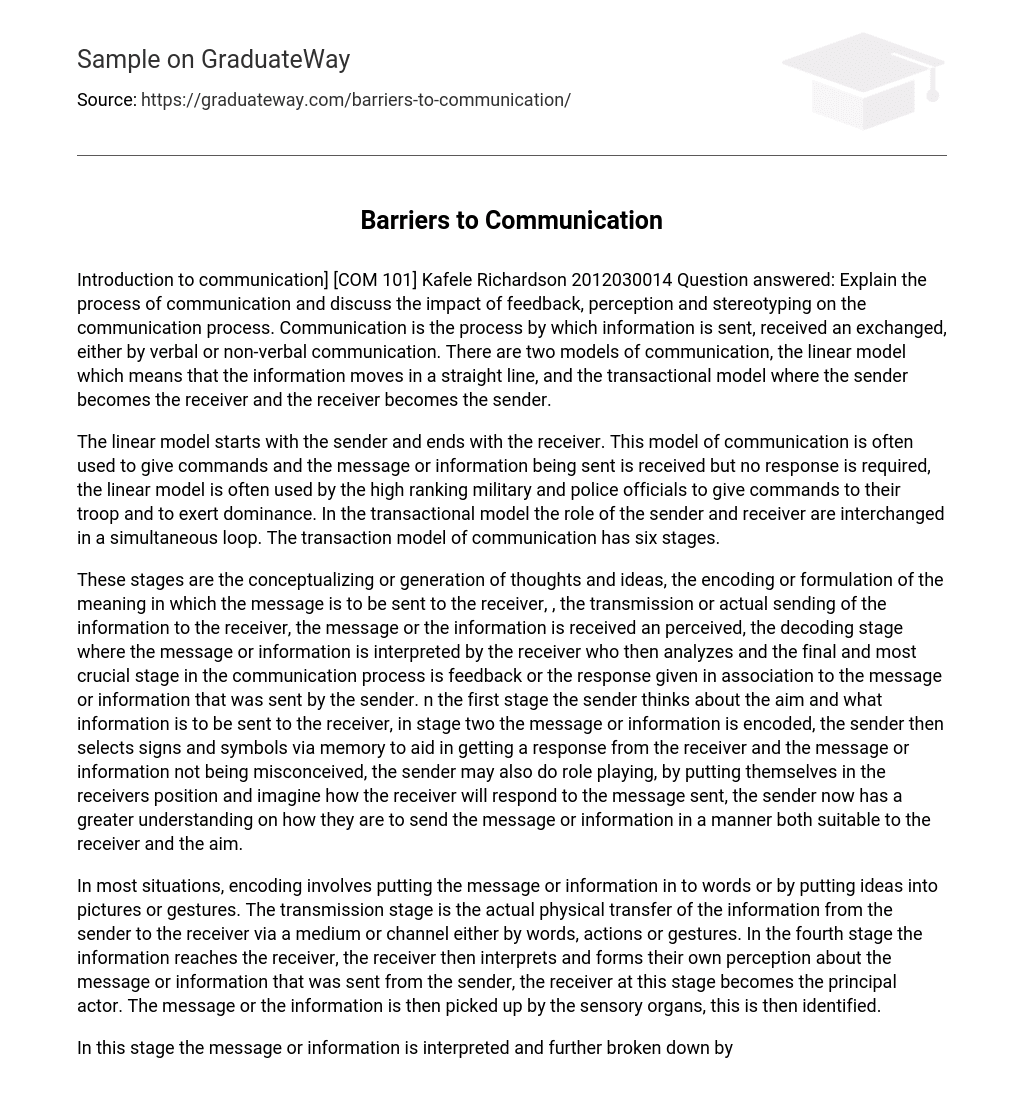Communication is the process by which information is sent, received an exchanged, either by verbal or non-verbal communication. There are two models of communication, the linear model which means that the information moves in a straight line, and the transactional model where the sender becomes the receiver and the receiver becomes the sender.
The linear model starts with the sender and ends with the receiver. This model of communication is often used to give commands and the message or information being sent is received but no response is required, the linear model is often used by the high ranking military and police officials to give commands to their troop and to exert dominance. In the transactional model the role of the sender and receiver are interchanged in a simultaneous loop. The transaction model of communication has six stages.
These stages are the conceptualizing or generation of thoughts and ideas, the encoding or formulation of the meaning in which the message is to be sent to the receiver, , the transmission or actual sending of the information to the receiver, the message or the information is received an perceived, the decoding stage where the message or information is interpreted by the receiver who then analyzes and the final and most crucial stage in the communication process is feedback or the response given in association to the message or information that was sent by the sender.
In the first stage the sender thinks about the aim and what information is to be sent to the receiver, in stage two the message or information is encoded, the sender then selects signs and symbols via memory to aid in getting a response from the receiver and the message or information not being misconceived, the sender may also do role playing, by putting themselves in the receivers position and imagine how the receiver will respond to the message sent, the sender now has a greater understanding on how they are to send the message or information in a manner both suitable to the receiver and the aim.
In most situations, encoding involves putting the message or information in to words or by putting ideas into pictures or gestures. The transmission stage is the actual physical transfer of the information from the sender to the receiver via a medium or channel either by words, actions or gestures. In the fourth stage the information reaches the receiver, the receiver then interprets and forms their own perception about the message or information that was sent from the sender, the receiver at this stage becomes the principal actor. The message or the information is then picked up by the sensory organs, this is then identified.
In this stage the message or information is interpreted and further broken down by the receiver, receiver then looks into memory an experience as to attempt to interpret the way in which the message or information is meant or portrayed by the sender and the final stage is where the receiver gives a response in conjunction to the message or information sent by the sender to the sender, then the roles are exchanged and the sender becomes the receiver and the receiver thus becomes the sender. The stages are then repeated until the sender or receiver ends the cycle or loop.
In the communication process there are many impacts the either hinders the communication process or assist in greater communication skills such as feedback or response, perception and stereotyping. In the communication process feedback is that integral part of the human communication process that allows the speaker to monitor the process and to evaluate the success of an attempt to get the desired response from the receiver, this is called a returned signal; it has a regulatory effect upon the speaker since the speaker must adjust to the feedback responses in order to be successful.
If clear feedback is given them the sender will note that the message was received, and in the way in which it was meant such as in public communication situations, the response of acceptance of the audience with their applause may be considered a feedback or the receivers giving a nod in acknowledgement.
Then there is perception, Perception is how we interpret different views based on our thoughts, if a message was interpreted wrong, and then there will be miss conception about the message for instance, if your boss told you, “May I speak with you,” then that message may be interpreted as what did I do wrong to warrant private attention rather than just the message that conveys that your boss wants to talk with you, or even if a random stranger walks up to you and ask “May I have a minute of your time” then you may start wondering if the person wants money, direction or if the person is trying to rob you.
Our perceptions can sometime also lead to stereotyping, this is when we have fixed emotions or thoughts about a particular group of people such as criminals, police officer, doctors, homosexuals, etc… and this can therefore hinder the communication process because we have these fixed perceptions of the people of that particular group if we were to meet a member of the group our expressions and behaviors are governed by what we believe about that group, it all depends on whether it is a negative or positive thought we have on the group, it will govern the way we interact, respond an talk to that person.
Bibliography
- www. shkaminski. com
- www. ehow. com
- www. reference. com
- www. wiki. answers. com





